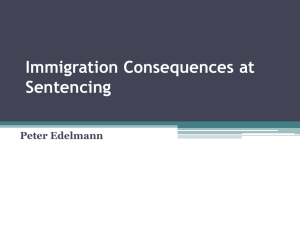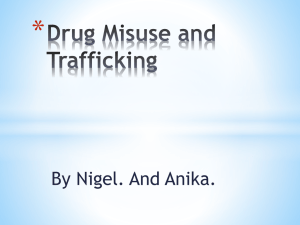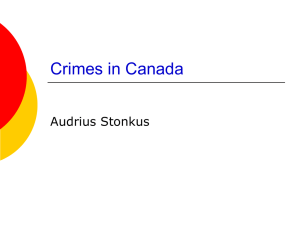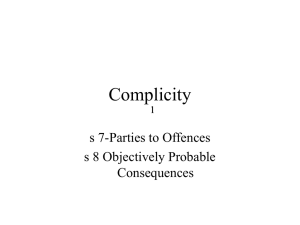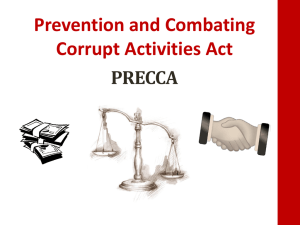Winnipeg Drug Treatment Court PowerPoint 2013
advertisement
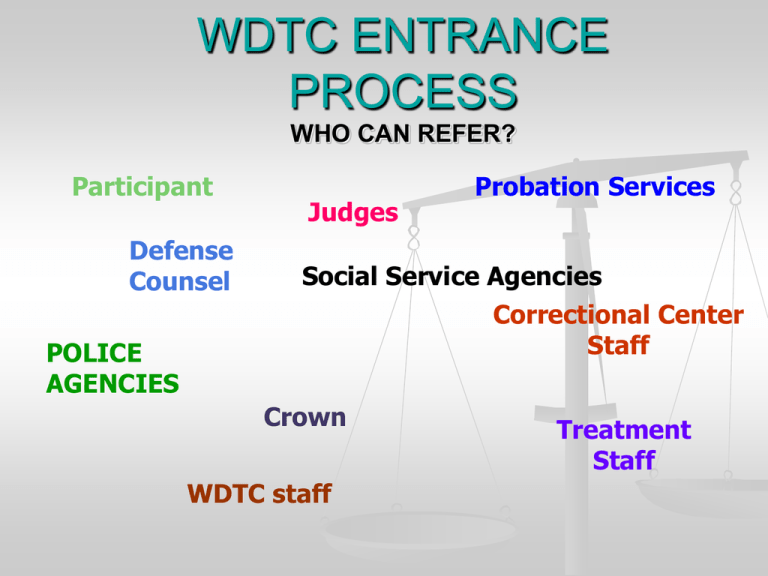
WDTC ENTRANCE PROCESS WHO CAN REFER? Participant Defense Counsel Judges Probation Services Social Service Agencies Correctional Center Staff POLICE AGENCIES Crown WDTC staff Treatment Staff How It Works Referral Process: Clients can self-refer or are referred by defence counsel. Some are recruited through word of mouth or advertisement in correctional facilities. They are screened in by a Crown and then assessed by the treatment team. WDTC Types of Offences/Offenders Possession - drug addicts; Traffickers (low level) who are selling so they can use; Break & Enter – those who are breaking in and stealing to support their drug habit; Forgery/Fraud – again done to support their drug habit; Purpose of sentencing 10. (1) Without restricting the generality of the Criminal Code, the fundamental purpose of any sentence for an offence under this Part is to contribute to the respect for the law and the maintenance of a just, peaceful and safe society while encouraging rehabilitation, and treatment in appropriate circumstances, of offenders and acknowledging the harm done to victims and to the community. Marginal note:Factors to take into consideration (2) If a person is convicted of a designated substance offence for which the court is not required to impose a minimum punishment, the court imposing sentence on the person shall consider any relevant aggravating factors including that the person (a) in relation to the commission of the offence, (i) carried, used or threatened to use a weapon, (ii) used or threatened to use violence, (iii) trafficked in a substance included in Schedule I, II, III or IV or possessed such a substance for the purpose of trafficking, in or near a school, on or near school grounds or in or near any other public place usually frequented by persons under the age of eighteen years, or (iv) trafficked in a substance included in Schedule I, II, III or IV, or possessed such a substance for the purpose of trafficking, to a person under the age of eighteen years; (b) was previously convicted of a designated substance offence; or (c) used the services of a person under the age of eighteen years to commit, or involved such a person in the commission of, a designated substance offence. Marginal note:Drug treatment court program (4) A court sentencing a person who is convicted of an offence under this Part may delay sentencing to enable the offender (a) to participate in a drug treatment court program approved by the Attorney General; or Marginal note:Minimum punishment (5) If the offender successfully completes a program under subsection (4), the court is not required to impose the minimum punishment for the offence for which the person was convicted. Table 4 WDTC Graduate and Discharged Client Comparisons on Legal and Risk Data Graduated Criminal History Yes No History of Violence Yes No 66.7% 33.3% 18.2% 81.8% Discharged 81.8% 18.2% 45.5% 54.5% Difference Comments -15.1% A criminal history is linked to reoffence. This difference is not as large as last year (more graduates have criminal histories this year) -27.3% Similar to last year, a history of violence is strongly associated with being discharged. Higher PRA ratings mean a greater likelihood of discharge. Of note, more clients classified as “high” graduated this year than in last year’s evaluation. Primary Risk Assessment* Low Medium High 3.1% 65.6% 31.3% 5.6% 13.9% 80.6% -2.5% +41.7% -49.3% Institutional Security Assessment Low Medium High 90.6% 9.4% 0 58.1% 41.9% 0 +32.5% Similar to last year, clients classified as low risk had a much higher graduation rate. CROWN ACCEPTANCE The offender has been charged with possession, possession for the purpose of trafficking/trafficking; Criminal Code offences associated with drug offences or a non-violent Criminal Code offence. The offender has a drug addiction. The offence was caused or motivated by the drug addiction. The accused and defense counsel must also have received sufficient disclosure to determine that the accused is able to plead guilty to the applicable Information(s). THE OFFENDER WILL NOT BE ELIGIBLE, IF ANY OF THE FOLLOWING CIRCUMSTANCES EXIST: 1. The offence was solely motivated by profit (for example a commercial grow operation); 2. For drug offences, the offence was committed near a schoolyard; playground or other area where children are commonly present; 4. For drug or prostitution offences, the offence involved a person under 18 years of age (for example, trafficking to minors; communication with a person under 18 years of age); 5. The offender has outstanding immigration issues which may result or has already resulted in a deportation order 6. The offender has any other serious outstanding criminal charges, whether federal or provincial. The Offender Will Generally Not Be ineligible If… 1. The offence involved the use or threatened use of a weapon; 2. The person has been charged with trafficking for commercial gain; 3.The drug offence involved risk to a young person; or 4. The offender is an associate or member of a gang or criminal organization ; 5. The drug offence was committed in circumstances that raise concerns about drug-impaired driving; 6. The person has a recent and/or significant history of violence. 7. The current offence involved violence. THE FOLLOWING FACTORS WILL ALSO BE CONSIDERED AND MAY RESULT IN INELIGIBILITY: •An indication that the resort to the DTC program is being used solely to avoid punishment rather than to address an addiction that contributed to the criminality in question should militate against admission to the DTC program. •Persons whose past conduct indicates an inability to comply with or maintain a previous court order, or to benefit from admission into a DTC program, will not generally be admissible. •Persons who have previously participated in a DTC program and either been expelled or withdrawn, as well as those who have graduated from a DTC program in the previous year, are generally not admissible to the DTC program. • Persons who are currently serving a conditional or intermittent sentence at the time of their application to the DTC will generally not be admissible as these sentences are generally incompatible with an intensive DTC program. LEGAL DISCLAIMER The determination of whether any of the above criteria have or have not been met will be solely in the discretion of the prosecutors associated with the Drug Treatment Court program. In making their determination, the prosecutors may consult such other persons as they consider appropriate (for example, treatment providers to determine the existence of a drug addiction). Process for admission Crown receive s referral Does participant meet criteria? Y WDTC screens Does participant meet criteria? N N Participant is not accepted and is referred back to court Y Participant begins assessment process WDTC Forms Application Form Waiver – Track 1 Waiver – Track 2 The Rules – Your Duties & Obligations WDTC Application Form All forms completed by accused and counsel together. Application Form contains the following: personal information relating to the accused; types and number of charges (which are verified with CCAIN); types of drugs addicted to; Date of last use; Previous treatment; Housing availability. WDTC Waivers 2 types – Track 1 & Track 2 Give up right to plead not guilty as they must plead guilty to either all or some of the charges upon entering WDTC; Give up their right to a trial; If they are discharged for any reason after 30 days of being in the program, they go straight to sentencing; If they choose to opt out or voluntarily withdraw before the 30 days, they are allowed to withdraw their pleas and continue in the regular court system. WDTC Waiver - Track 1 Designed for offenders who are charged with possession of a controlled substance and who have a demonstrable dependence on that substance. The Crown will withdraw the charge(s) against successful Track 1 participants. WDTC Waiver - Track 2 Designed for offenders who are charged with trafficking and/or possession for the purpose of trafficking and certain Criminal Code offences who also have a demonstrable dependence on a controlled substance. An individual with an extensive criminal record charged with possession of a controlled substance may be considered for this track. Upon successful completion, Track 2 participants will be given a non-custodial sentence. WDTC Bail Conditions The following is a list of some of the DTC bail conditions which are imposed by the Court: attend and participate actively in treatment; attend for urinalysis as directed; honestly report all drug and alcohol use; be honest with treatment providers and the court; attend court as required; live at a specified address and don’t move from that address without first getting the court’s approval; advise the court of any new charges that arise while in WDTC; be subject to curfews, boundaries and non – association conditions; abstain from the use of alcohol, non-medically prescribed drugs and other intoxicants; Drug traffickers – subject to a must not own or possess a cell phone, blackberry or any other electronic communication device.
